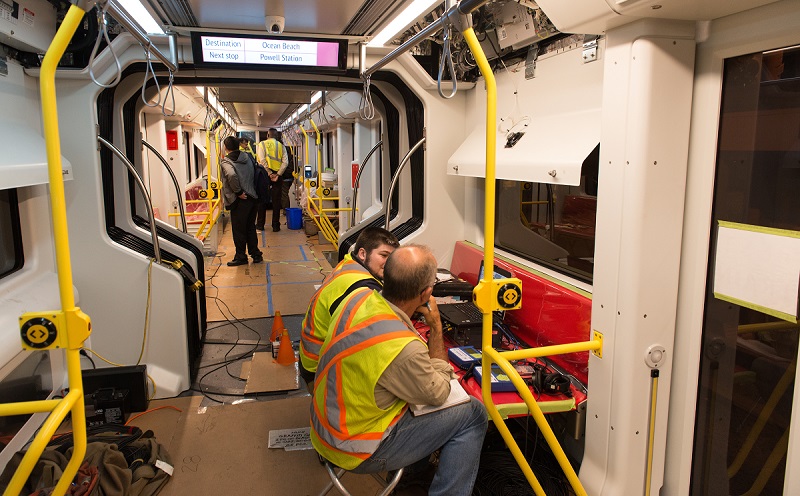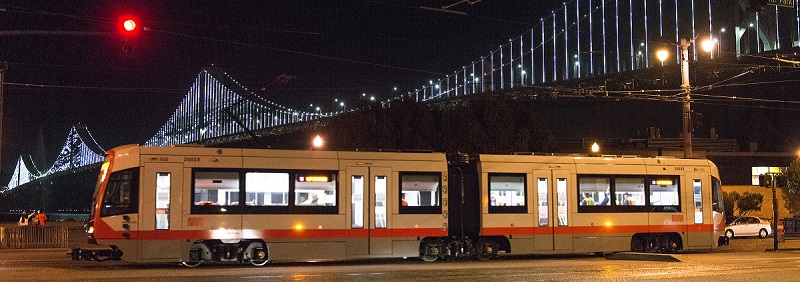System Safety and the New Trains

Technicians Performing Noise and Vibration Testing on New Siemens LRV, July 21, 2017
After a series of recent events, we wanted to take the opportunity to provide our customers with an explanation of our LRV4 systems safety process and how we’ve handled the rollout of this new fleet. Since we first initiated the procurement back in 2014, safety has always been – and always will be – our first priority. We want to shed light on the extensive design, testing and safety certification processes that are built into the program. The public and our oversight bodies deserve full transparency into how this program is run.
Each transit system in the United States has a unique operating environment and specific demands required of their fleet. For that reason, transit vehicle procurements are a long and complex engineering project that necessarily results in multiple iterations of revisions, updates and re-engineering. Siemens is our partner in this procurement project; they have been a proactive and responsive vendor, consistently providing solid engineering and maintenance support since their selection in 2014. This does not mean we have not faced challenges. The series of high-profile issues that have come to light over the last several weeks demonstrate how difficult such a project can be and the importance of maintaining a continuous focus on safety.
Because every new transit vehicle we buy for San Francisco is highly customized for our unique environment, there are multiple stages to certify that the vehicle is safe for operation. At each stage of the design, engineers present the vehicle for review first to an internal safety committee, led by a Chief Safety Officer, and then to the regulating body. In California, light rail vehicles are regulated by the California Public Utilities Commission (CPUC), the project is also governed by the Federal Transportation Authority (FTA) procurement requirements. Even after final design review and initial safety certification, vehicles undergo significant functionality and safety testing on a test track at the plant in Sacramento before being delivered to San Francisco.
The first three new LRV trains delivered spent eleven months in testing and certification within the SFMTA system before achieving final safety certification. When and if, an LRV successfully completes field testing, the project safety and security certification committee certifies that the vehicle has been manufactured in accordance with the previously approved design and files a request to place that vehicle in revenue service with the CPUC. Each subsequent vehicle is required to undergo its own safety vetting process before entering service. Until these certifications have been acquired, the vehicle cannot carry passengers in service. The safety certification process validates both the overall design as well as the individual vehicle against national and international standards.
Even with the rigorous industry-standard safety certification processes in place, all transit vehicle procurements have systems in place to deal with manufacturing and operations issues – large or small – as they arise. This is a standard practice nationwide for any-size procurement. As issues are identified, solutions are developed and changes are incorporated into the manufacture of subsequent vehicles. An example of this would be the feedback we received regarding the height of the seats. After another round of outreach, we’ve been able to identify possible solutions to the vehicle seating that would fit the needs of all of our riders. Vehicles already certified and accepted by the SFMTA undergo a retrofit and recertification to ensure consistency across the fleet.
As with any vehicle procurement, the SFMTA will continue to make improvements and adjustments to the fleet to make sure San Francisco has the best trains possible to fit the city’s needs. Siemens is contractually obligated to deliver vehicles that conform to the original specifications set out by the SFMTA. As part of this process, we are committed to acting with transparency, while we work through actions that address the concerns of stakeholders, most especially our customers.
Last week, a test train was outfitted with an updated door design. It has been tested in non-revenue service and the results were reviewed by the Safety Certification Committee. This train will now operate in revenue service staffed by two expert operators. One operator will drive the train, while the other observes the rear single panel door.

